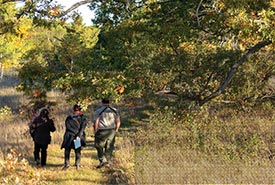A lasting impact

Hazel Bird Nature Reserve, ON (Photo by Kristina Smith)
Tall grass ecosystems such as the Rice Lake Plains were once plentiful in Ontario. Today, all but three per cent are lost. The Hazel Bird Nature Reserve is an example of the impacts of NCC’s long-term stewardship actions across the country.
By Patricia Hluchy, award winning writer and journalist
October weather in southeastern Ontario doesn’t get any better. By 8 a.m., the temperature at the Hazel Bird Nature Reserve is already 10 degrees, beneath a cloudless sky. already 10 degrees, beneath a cloudless sky.
Oblique autumn sunshine makes the colours of the prairie grasses and turning oak leaves especially vibrant. Gerry Bird, son of the legendary naturalist after whom the reserve is named, spots a variety of avian species: a small flock of eastern bluebirds, a northern harrier, an eastern phoebe, a sharp-shinned hawk, a northern goshawk and an eastern meadowlark, the latter listed as threatened provincially and nationally.
As our group tours the 118-hectare (292-acre) site, about a 90-minute drive east of Toronto, we also spot an eastern hog-nosed snake. It, too, is considered threatened in Ontario and federally, but it is making a comeback at Hazel Bird thanks to almost a decade of stewardship by the Nature Conservancy of Canada (NCC), which bought the property in 2011 as part of its efforts to conserve the Rice Lake Plains.
Our visit took place in the fall of 2019. And this autumn, NCC is marking the 15th anniversary of its natural area con- servation plan for the Rice Lake Plains — the organization’s first such strategy to look at conservation from a landscape
approach. The plan outlined the actions that were needed to protect this natural area. It has guided NCC’s efforts to re- habilitate the plains’ degraded and now-rare ecosystems. In the past, Ontario was a mix of forests, wetlands and tall grass ecosystems — prairie, oak savannah and oak woodland. Today, after centuries of development, these once plentiful plains are now one of the rarest ecosystems in the province.
To develop and implement the plan, NCC has joined forces with partners, including the Alderville First Nation, private landowners, conservation groups and governments, to conserve and restore habitats in the rolling hills of the 40,500-hectare (100,000-acre) plains. They are part of the glacial landform known as the Oak Ridges Moraine, with its preponderance of dry, sandy loam soil. Today, just 10 per cent of the original tall grass ecosystems remains on this continent, and less than three per cent in Ontario. Their decline has also put pressure on animals that rely on these habitats, including ghost tiger beetle, barn swallow, bobolink, common nighthawk and eastern whip-poor-will.
Tall grass awakening
On my visit last year, we walked most of the Hazel Bird Nature Reserve. It was an idyllic stroll, given the site’s vast sightlines and var- iety of terrain, which also includes sand bar- rens and a stunning view from a lookout, and its wealth of plants and animals. Our guide was Val Deziel, NCC’s coordinator of conserv- ation biology for Central Ontario East since 2012. Passionate about the Rice Lake Plains, Deziel points out that non-native Scotch pine dominated the Hazel Bird Nature Reserve before NCC got involved. “If NCC hadn’t bought this property, looking east this land would be 80 per cent Scotch pine,” said Dezi- el, a native of the area. “We’re fighting one battle at a time: first get rid of the Scotch pine, then plant the oaks and prairie plants and bring it back to a savannah.”
NCC staff call it the “tall grass awakening.” The Rice Lake Plains is North America’s east- ernmost tall grass landscape, and NCC’s work there follows decades of similar success in the Prairie provinces.
Taking out the pines is labour-intensive work. But Deziel and her team have accom- plished a whole lot more by getting rid of other non-native invasive species, including dog-strangling vine, common buckthorn
and spotted knapweed. Meanwhile, they have reintroduced native wildflowers and prairie grasses. They have also planted New Jersey tea, a once-prolific prairie shrub that the mottled duskywing butterfly, which is endan- gered in Canada and at risk throughout its global range, likes to lay its eggs on.
This is an excerpt of a story that first appeared in the Fall 2020 issue of the Nature Conservancy of Canada Magazine. Donors who contribute at least $25 or more per year will receive the magazine. Click here to donate today and start receiving the magazine.



